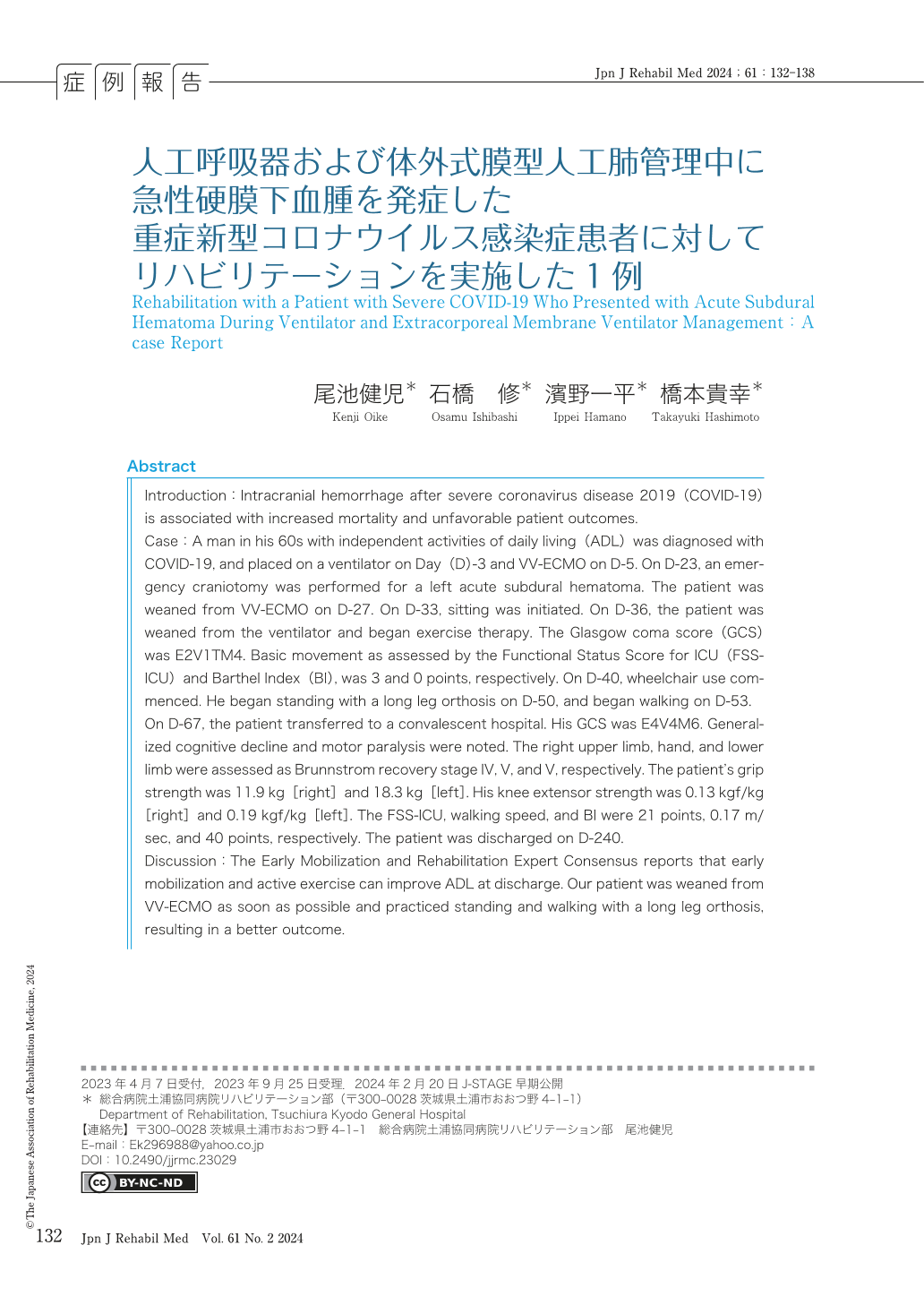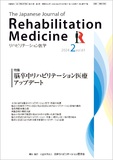Japanese
English
- 販売していません
- Abstract 文献概要
- 1ページ目 Look Inside
- 参考文献 Reference
はじめに
新型コロナウイルス感染症(coronavirus disease-2019:COVID-19)は2019年に中国で報告されて以降,急速に世界中に拡大し,変異を繰り返しながら蔓延している1).COVID-19の臨床症状は発熱や咳,全身倦怠感,呼吸困難など2)で軽症例や中等症例では予後良好であるが,重症例では重症肺炎や急性呼吸促拍症候群を呈し集中治療下での人工呼吸器管理を必要とし予後不良である3).さらに,重度の呼吸機能障害を呈した場合は多くが腹臥位療法や体外式膜型人工肺(venous-venous extracorporeal membrane oxygenation:VV-ECMO)管理が必要となる4).
また,COVID-19は呼吸器合併症以外に心血管系や血栓塞栓症,炎症性合併症などのさまざまな合併症が報告されている5).中でも血栓塞栓症は凝固能の異常亢進により引き起こされ,重症例で合併率が高く,高い致死率との関連が報告されている6).そのため,予防的な抗凝固療法が施行されているが,出血性合併症が問題となる.重症COVID-19後に頭蓋内出血を呈すると早期発見困難な例も多く,死亡率の上昇や退院時の転帰が不良となることが報告されている7).
集中治療を要する重症患者が集中治療室(intensive care unit:ICU)退室後に生じる機能障害は集中治療後症候群(post intensive care syndrome:PICS)と呼ばれ,退院後,長期的に生活の質を低下させることや社会復帰に向けて大きな障壁となることが報告されている8).重症COVID-19においても人工呼吸器管理が長期化することでICU退室時や退院時に身体機能障害が残存し9),退院後1年後もPICSが残存する10)ことが報告されている.そのため早期リハビリテーション治療が重要とされており11),早期離床を中心とした介入が機能的な自立度を改善させることが報告されている12).一方で合併症を併発した重症COVID-19に関するリハビリテーション治療および長期経過に関する報告は乏しい.COVID-19の重症度が高いほど合併率が高い報告6)もあることから合併症を併発した重症COVID-19に対するリハビリテーション治療および長期経過に関する報告は臨床上有意義であると考える.
今回,人工呼吸器およびVV-ECMO管理中に急性硬膜下血腫(acute subdural hematoma:ASDH)を発症した重症COVID-19症例に対して多職種が連携してリハビリテーション治療を実施し,発症から1年間の経過を評価したため以下に報告する.
なお,本症例報告において論文掲載についての同意を本人および家族に書面で説明し同意を得た.また,個人は特定できないように十分に配慮した.
Abstract Introduction:Intracranial hemorrhage after severe coronavirus disease 2019 (COVID-19) is associated with increased mortality and unfavorable patient outcomes.
Case:A man in his 60s with independent activities of daily living (ADL) was diagnosed with COVID-19, and placed on a ventilator on Day (D)-3 and VV-ECMO on D-5. On D-23, an emergency craniotomy was performed for a left acute subdural hematoma. The patient was weaned from VV-ECMO on D-27. On D-33, sitting was initiated. On D-36, the patient was weaned from the ventilator and began exercise therapy. The Glasgow coma score (GCS) was E2V1TM4. Basic movement as assessed by the Functional Status Score for ICU (FSS-ICU) and Barthel Index (BI), was 3 and 0 points, respectively. On D-40, wheelchair use commenced. He began standing with a long leg orthosis on D-50, and began walking on D-53.
On D-67, the patient transferred to a convalescent hospital. His GCS was E4V4M6. Generalized cognitive decline and motor paralysis were noted. The right upper limb, hand, and lower limb were assessed as Brunnstrom recovery stage IV, V, and V, respectively. The patien's grip strength was 11.9 kg [right] and 18.3 kg [left]. His knee extensor strength was 0.13 kgf/kg [right] and 0.19 kgf/kg [left]. The FSS-ICU, walking speed, and BI were 21 points, 0.17 m/sec, and 40 points, respectively. The patient was discharged on D-240.
Discussion:The Early Mobilization and Rehabilitation Expert Consensus reports that early mobilization and active exercise can improve ADL at discharge. Our patient was weaned from VV-ECMO as soon as possible and practiced standing and walking with a long leg orthosis, resulting in a better outcome.

Copyright © 2024, The Japanese Association of Rehabilitation Medicine. All rights reserved.


